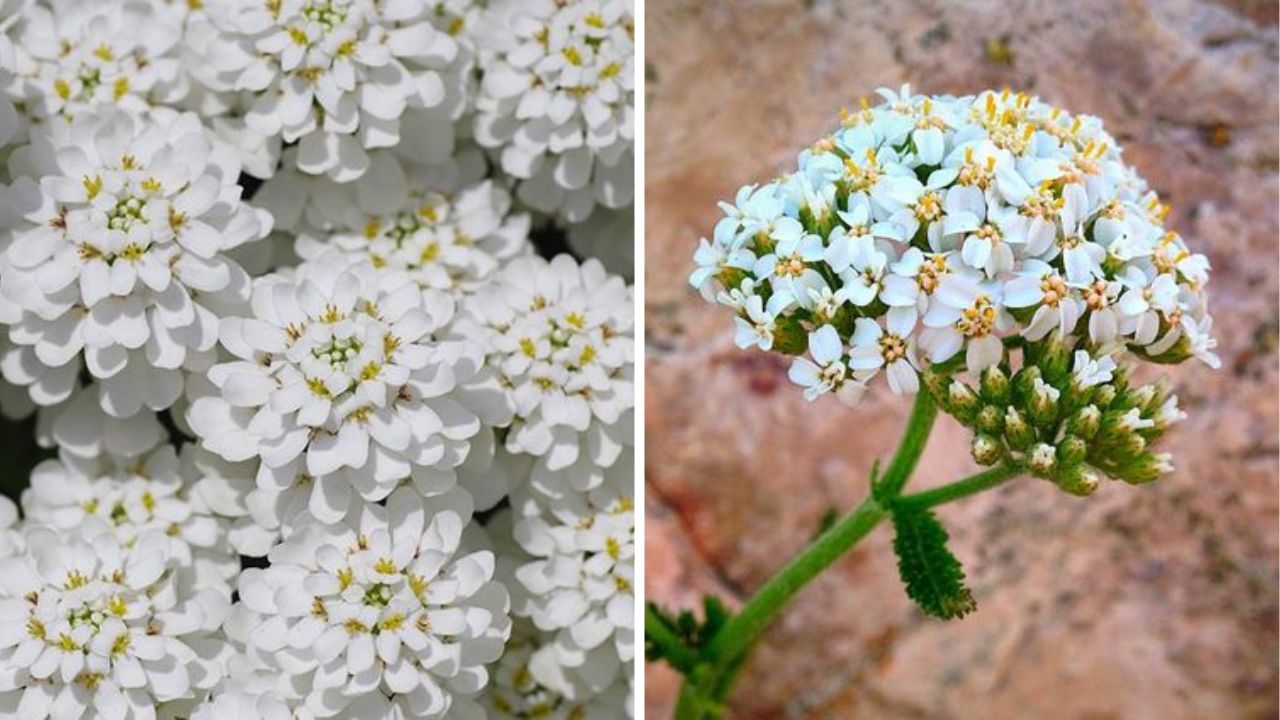Candytuft is a woody subshrub that blooms and is sometimes mistaken for a perennial because of its clusters of tiny, pastel, or white flowers with many petals. Candytuft can withstand a range of temperatures and thrives in full to partial sun, well-draining soil of any pH, and drier, less humid environments. Candytuft has a mildly harmful effect on people.
Candytuft Plant Overview

| Common Name | Candytuft |
| Botanical Name | Iberis sempervirens |
| Family | Brassicaceae |
| Plant Type | Shrub, herbaceous, perennial |
| Mature Size | 12–18 in. tall, 12-16 in. wide |
| Sun Exposure | Full, partial |
| Soil Type | Well-drained |
| Soil pH | Acidic, neutral, alkaline |
| Bloom Time | Spring |
| Flower Color | White, pink, purple, red |
| Hardiness Zones | 3–9 (USDA) |
| Native Area | Europe, Mediterranean |
| Toxicity | Toxic to humans |
Candytuft Care

The following are the primary maintenance needs for candytuft growth.
- During the hottest parts of the day, plant in the sun with some shade.
- Plant in somewhat more alkaline, but well-drained, gravely soil (it can withstand varying pH values).
- Water newly planted plants during dry spells, but as the plant ages, it learns to withstand drought.
Light Requirements
Candytuft grows best in full sun, however it will tolerate partial shade. Zones 8 and 9 are an exception, as they benefit from some afternoon shade during the warmest part of the day.
Soil and Potting
Native to southern Europe, especially the Mediterranean coast, candytufts prefer the type of gravelly soil that grows in their native region. More essential, you must make sure they have good drainage. Candytuft is ideal for rock gardens since it prefers well-drained soils. Although it has good tolerance for both slightly acidic and neutral soils, this perennial prefers to be cultivated on the ground with an alkaline pH.
Watering
Candytuft flowers can withstand some drought once they have been established, but you should always water new plants, especially in dry spells. Candytuft plants are a great option for xeriscaping because they can easily survive two or three weeks without being watered.
Temperature and Environment
USDA zones 3 through 9 are typically thought to be hardy for candytuft, however this can vary depending on where you live. It is a hardy perennial in chilly climates, an evergreen in warm climates, and almost an annual in zone 3’s intense winters unless it is well mulched.
The air around candytuft is often dryer in its natural habitat. Because of this, it is not advised in humid regions like the Southeast of the United States, where fungal illnesses are more common and flowers tend to wilt.
Fertilization
Candytuft does not require fertilization, although it can assist in guaranteeing a profusion of blossoms. Candytuft will grow more quickly if a slow-release fertilizer is administered in the early spring. For optimal effects, use a mix that is heavy in phosphorus and low in nitrogen. Refer to the product label for directions on how much to use.
Types of Candytuft
Here are a few well-liked candytuft varieties:
‘Purity’: Stunning white flowers with a maximum height of 10 inches and a somewhat wider spread.
‘Nana’:This smaller variety has beautiful white blossoms and grows to a height of 6 inches.
‘Autumn Snow’: This well-known cultivar has autumn reblooms.
‘Pink Ice’: It is a favorite in the spring, with pink flowers that have dark pink cores.
‘Alexander’s White’: The foliage of this low-growing variety is delicately textured.
‘Little Gem’: This form is a real dwarf, at only 6 inches tall.
‘Purity’: This cultivar, which stands 8 inches tall, spreads widely.
‘Snowflake’: Broader, more leathery leaves with very enormous flower clusters.
Pruning
After flowering, trim off one-third of the top foliage to keep candytuft looking neat. This will prevent the plant from becoming lanky. When flowering is over, some gardeners like to use a string trimmer to deadhead candytuft. In the border garden, the plant may become fairly straggly if this yearly trimming is skipped.
Legginess, meanwhile, might be a plus if you’re using candytuft flowers to cover a retaining wall. In this instance, just trim them if you feel that the stems are becoming overly woody. Reduction of growth will result in regrowth.
Propagating Candytuft
The stems that root themselves around the mother plant are how the plant regenerates itself in warmer climates. The ideal way of propagation in colder climates, where the plant is more likely to die back to the ground every winter, is to divide the roots every few years. Since this process takes time, using stem cuttings is not advised. Here’s the breakdown of roots.
- Using a shovel, remove the entire root cluster in the fall, just before the plants go into winter dormancy.
- Cut the cluster into two or three pieces with a sharp knife or garden trowel. Verify that there are stems and a robust cluster of roots in every region.
- Replant the pieces right away in their new places, in well-loosened soil that has been modified to increase drainage, if needed.
How to Grow Candytuft From Seed?
After the flowers fade, the native species of candytuft can be propagated by gathering seeds from the remaining seed pods. However, named cultivars seldom “come true” from their seeds; hence, the best way to propagate those varieties is through vegetative propagation (see root division above).
Pure species seeds should be started indoors in little containers or directly sown into the garden in the spring, once all risk of frost has gone. Follow these steps:
- Plant the seeds in the well-loosened soil, about 1 inch deep, and give them plenty of water.
- After the seeds sprout, keep them moist, and water them frequently until the plants are well-established.
- When starting from seed, put seeds about 6 inches apart to achieve a ground cover effect more quickly, even though mature plants can reach up to 18 inches in height.
Potting and Repotting Candytuft

Candytufts are a difficult plant to cultivate in containers due to their unappealing bloom, strong scent, and slow growth rate. Despite this, they may be grown in large pots. Should you decide to cultivate them in pots, pick a sizable, well-ventilated container that is quite roomy and add regular potting soil mixed with fine gravel or sand to enhance the drainage?
Potted candytuft needs a little bit more watering than it would if it were planted in the ground, just like any perennial cultivated in a container. A potted candytuft plant can be overwintered by being moved to a protected spot or being dug into the ground up to the pot’s lip. Due to its moderate growth, it only requires repotting once every few years.
Overwintering
Cut the stems back to 3 or 4 inches after the leaves have been damaged by frost in areas where the plant behaves like a regular perennial and dies back completely in the winter.
In late October, some gardeners in colder climates (zones 3, and 4) cover their plants with gently placed pine boughs to protect them from the chilly, dry winter winds. Applying a regular mulch layer of one to two inches will yield the same results. There is no need for winter protection in warmer climates.
Common Pests & Plant Diseases
The majority of insect pests avoid candytuft, but you can have issues with caterpillars, slugs, and snails, which might all require a variety of techniques and some time to eradicate.
Candytuft is most commonly affected by root rot, which occurs when the plant struggles in soggy, poorly drained-soil. Plants with severe damage should be removed. Fungal infections such as powdery mildew, down mildew, rust, gray mold, and fungal leaf spots can cause various issues. Fungal illnesses are rarely lethal, but they are more common in humid environments with poor air circulation. A fungicidal spray can be used to treat these infections if the deformity is thought to be severe.
How to Get Candytuft to Bloom?
Bloom Months
Candytuft has several weeks of heavy blooms in late spring and early summer.
How Does a Candytuft Flower Smell and Look?
With an abundance of white or pink blossoms in a flat-topped raceme of small petals approximately 2 inches wide, candytuft adds color to gardens. These plants are a fantastic choice for moon gardens because of their hue, which contrasts well with the dark green foliage. Most of the time, the flowers don’t smell sweet, and gardeners are divided on the candytuft’s scent—it smells like cabbage.
How to Encourage More Blooms?
Candytuft often doesn’t require encouragement to bloom as long as it is receiving plenty of sunlight and is planted in well-drained soil. Optimizing blooming can be achieved by lightly fertilizing with a phosphorus-rich fertilizer in the early spring. A candytuft plant may be overwatered if it does not bloom as anticipated; an unsatisfactory bloom season could result, for example, from extremely wet spring weather.
Common Problems With Candytuft
If given the right growing conditions, candytuft is usually a reasonably trouble-free plant. However, you might see the following issues.
Yellowed Leaves
When a candy-tuft plant produces yellow leaves, it usually means that the environment is too hot, too damp, or too humid. Although you have no control over the temperature, watering your plants first thing in the morning might help lower the humidity, which can lead to yellowing leaves.
Stunted Growth
A plant that appears stunted could have clubroot, a fungal disease that affects cabbages and other members of the Brassicaceae family. Deformed roots are usually easy to spot if you dig up a plant that exhibits these signs. Plants that are impacted must be taken out and killed.

Pingback: Pilea Involucrata Complete Guide To Grow And Care - flowerofusa.com